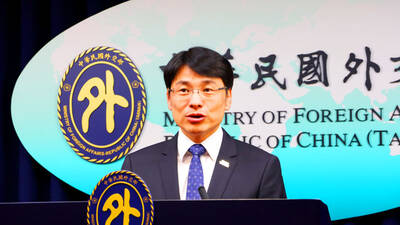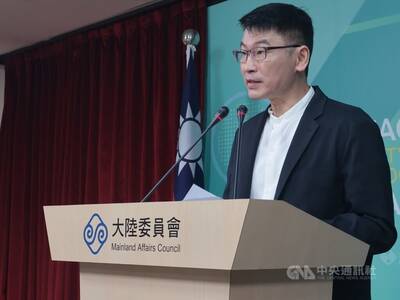Chanthu was upgraded to a stronger typhoon yesterday, the Central Weather Bureau said, adding that it might not issue a land alert for the typhoon when it comes close to Taiwan on Sunday.
As of 2pm yesterday, Chanthu was centered 1,330km southeast of Olaunpi (鵝鑾鼻). It was moving northwest at 21kph, with maximum sustained winds of 173kph.
The typhoon’s radius had expanded to 120km, the bureau said.

Bureau forecaster Wang Chun-shian (王君賢) said that a sea alert for Typhoon Chanthu could be issued tonight or early tomorrow morning as it is expected to pass through the Bashi Channel.
“As the typhoon’s radius is only 120km, whether a land alert would be issued requires more observation,” Wang said
Taiwan would be under the influence of the typhoon from Saturday to Monday, he said.
Due to ocean conditions, Chanthu could strengthen when it approaches the Bashi Channel, Wang said.
The typhoon’s structure would be slightly weakened by the topography when it moves closer to Luzon Island, he said.
The bureau’s projected path for the typhoon could change depending on the strength of a Pacific high-pressure system, Wang said.
“Chanthu’s path would move slightly north if the high-pressure system weakens. However, if the high-pressure system remains strong, the typhoon’s path could veer to the south. Data we have at the moment show that the high-pressure system might weaken, but we still need to monitor its development,” he said.
Typhoon Chanthu and Tropical Storm Conson were about 1,200km apart and both are moving northwest, Wang said.
Whether they would generate the Fujiwara effect, where two storms orbit each other and lead to more rain, would be better understood when they have moved closer to China, he said.
Between Saturday and Monday next week, thundershowers or showers are forecast for Hualien and Taitung counties, and the Hengchun Peninsula, the bureau said.
Starting tomorrow, rogue waves could appear off the north, east and southwest coasts, and the Hengchun Peninsula, as well as Penghu and Kinmen counties, it said.

ENDORSING TAIWAN: Honduran presidential candidate Nasry Afura said that Honduras was ‘100 times better off’ when it was allied with Taipei The Ministry of Foreign Affairs yesterday said it would explore the possibility of restoring diplomatic relations with Honduras based on the principle of maintaining national interests and dignity. The ministry made the remarks in response to reporters’ questions regarding an article titled: “Will Taiwan Regain a Diplomatic Ally?” published in The Diplomat on Saturday. The article said Honduras’ presidential election in November could offer Taiwan the chance to regain an ally, as multiple candidates have promoted re-establishing diplomatic relations with Taiwan. Honduras severed diplomatic ties with Taiwan in March 2023 in favor of Beijing, but since switching its diplomatic recognition,

A fourth public debate was held today about restarting the recently decommissioned Ma-anshan Nuclear Power Plant, ahead of a referendum on the controversial issue to be held in less than two weeks. A referendum on Aug. 23 is to ask voters if they agree that “the Ma-anshan Nuclear Power Plant should continue operations upon approval by the competent authority and confirmation that there are no safety concerns.” Anyone over 18 years of age can vote in the referendum. The vote comes just three months after its final reactor shut down, officially making Taiwan nuclear-free. Taiwan People’s Party Chairman Huang Kuo-chang (黃國昌) represented

Scoot announced yesterday that starting in October, it would increase flights between Taipei and Japan’s Narita airport and Hokkaido, and between Singapore and Taipei. The low-cost airline, a subsidiary of Singapore Airlines, also said it would launch flights to Chiang Rai in Thailand, Okinawa and Tokyo’s Haneda airport between December and March next year. Flights between Singapore and Chiang Rai would begin on Jan. 1, with five flights per week operated by an Embraer E190-E2 aircraft, Scoot said. Flights between Singapore and Okinawa would begin on Dec. 15, with three flights per week operated by Airbus A320 aircraft, the airline said. Services between Singapore

The Mainland Affairs Council (MAC) yesterday announced a ban on all current and former government officials from traveling to China to attend a military parade on Sept. 3, which Beijing is to hold to mark the 80th anniversary of the end of the Second Sino-Japanese War. "This year marks the 80th anniversary of the end of World War II and the Republic of China’s victory in the War of Resistance [Against Japan]," MAC Deputy Minister and spokesperson Liang Wen-chieh (梁文傑) told a regular news briefing in Taipei. To prevent Beijing from using the Sept. 3 military parade and related events for "united